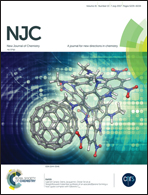Improved activity of palladium nanoparticles using a sulfur-containing metal–organic framework as an efficient catalyst for selective aerobic oxidation in water†
Abstract
A simple and efficient nanostructured catalyst system was developed, comprising Pd nanoparticles stabilized by thiophene groups in a metal–organic framework (MOF). Pd species were deposited into the DUT-67(Zr) structure and reduced to nanoparticles that could be stabilized by the synergistic effect of thiophene groups and confinement in the MOF pores. Increasing the interaction time for palladium entry into the MOF cavities led to more effective incorporation into the metal–organic framework, which produced a more efficient catalytic system. Reduction was performed using NaBH4 or N2H4. The catalysts were characterized by N2 adsorption–desorption analysis, infrared spectroscopy, powder X-ray diffraction, scanning electronic microscopy, and transmission electron microscopy. Selective aerobic oxidation of alcohols in neat water under an O2 atmosphere was achieved with 0.5%Pd/DUT-67(Zr) containing Pd nanoparticles created using NaBH4. Furthermore, the catalyst could be easily separated from the reaction mixture by simple filtration and reused at least ten times without any significant loss in catalytic efficiency under the investigated conditions.



 Please wait while we load your content...
Please wait while we load your content...